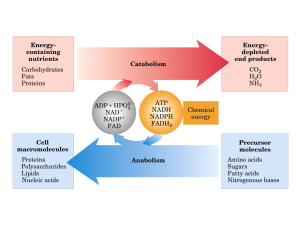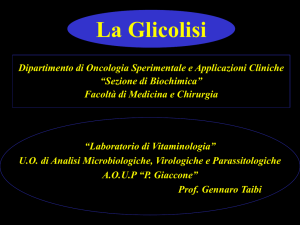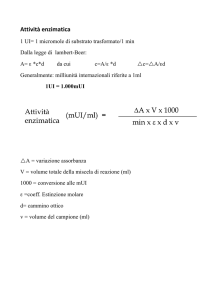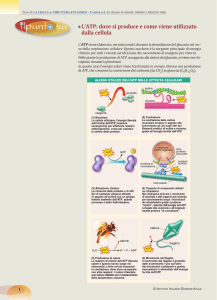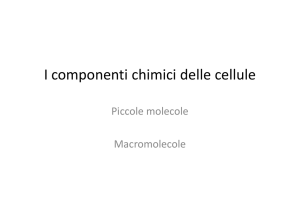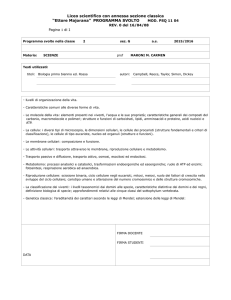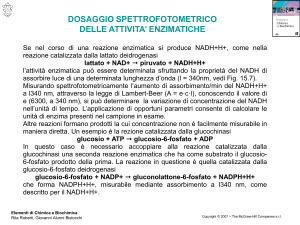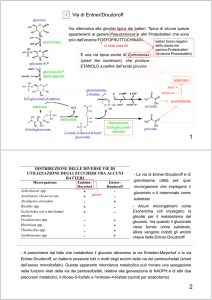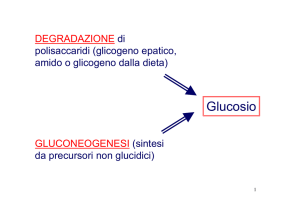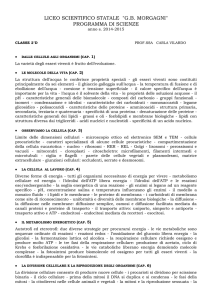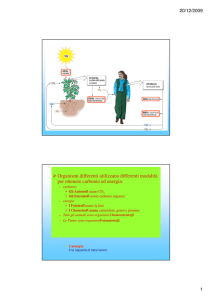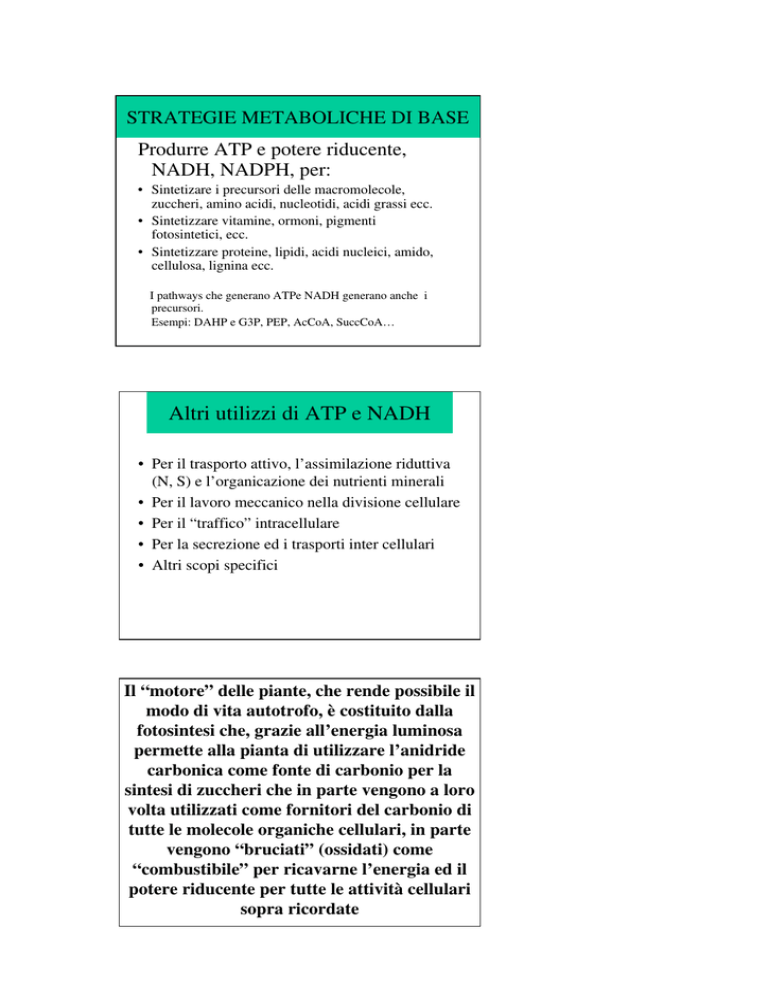
STRATEGIE METABOLICHE DI BASE
Produrre ATP e potere riducente,
NADH, NADPH, per:
• Sintetizare i precursori delle macromolecole,
zuccheri, amino acidi, nucleotidi, acidi grassi ecc.
• Sintetizzare vitamine, ormoni, pigmenti
fotosintetici, ecc.
• Sintetizzare proteine, lipidi, acidi nucleici, amido,
cellulosa, lignina ecc.
I pathways che generano ATPe NADH generano anche i
precursori.
Esempi: DAHP e G3P, PEP, AcCoA, SuccCoA…
Altri utilizzi di ATP e NADH
• Per il trasporto attivo, l’assimilazione riduttiva
(N, S) e l’organicazione dei nutrienti minerali
• Per il lavoro meccanico nella divisione cellulare
• Per il “traffico” intracellulare
• Per la secrezione ed i trasporti inter cellulari
• Altri scopi specifici
Il “motore” delle piante, che rende possibile il
modo di vita autotrofo, è costituito dalla
fotosintesi che, grazie all’energia luminosa
permette alla pianta di utilizzare l’anidride
carbonica come fonte di carbonio per la
sintesi di zuccheri che in parte vengono a loro
volta utilizzati come fornitori del carbonio di
tutte le molecole organiche cellulari, in parte
vengono “bruciati” (ossidati) come
“combustibile” per ricavarne l’energia ed il
potere riducente per tutte le attività cellulari
sopra ricordate
Durante la fase
luminosa della
fotosintesi si
generano ATP e
riducenti da
usare per
assimilare il C,
ma anche N ed S
Ruolo centrale
del metabolismo
dei carboidrati
nel fornire gli
scheletri
carboniosi per le
reazioni
biosintetiche
Ossidazione del saccarosio
In assenza di
ossigeno, per
riossidare il
NADH, si
innescano pathways
fermentativi
Conversion of sucrose to pyruvate during glycolysis in plants. The conversion of sucrose
to pyruvate involves an initial input of ATP but leads to formation of an even greater
amount of ATP via substrate-level phosphorylation, Also involved is an oxidation coupled
to the reduction of NAD'to NADH. The products of sucrose catabolism are described
here as two hexoses. Depending on the enzyme activity involved, sucrose can be
converted to fructose and glucose or to fructose and UDP-glucose
The mitochondrion is the principal organelle of eukaryotic respiration. Plant
mitochondria appear as spherical or rod-shaped entities 0.5 to 1.0 4m in
diameter and 1 to 3 4m long. The number of mitochondria per plant cell varies
and is related primarily to the metabolic activity of the particular tissue.
However, the concentration of mitochondria per unit volume of cytoplasm
usually remains similar during different developmental stages of the same cell
type. For example, the small cells of the root cap of maize seedlings contain
approximately 200 mitochondria each, whereas the much larger mature root tip
cells may have approximately 2000 mitochondria each. In very active cells,
such as phloem companion cells, secretory cells, and transfer cells, a large
fraction (up to 20%) of the volume of the cytoplasm may be occupied by
mitochondria. On the other hand, some unicellular algae (such as
Chlatnydomonas) contain only a few mitochondria per cell. With a few
exceptions (e.g., the very active cell types mentioned above), the density of
mitochondria observed in most plant cells is less than that found in a typical
animal cell. However, the respiratory rates of mitochondria isolated from
plants are generally higher than in those isolated from animals.
Analogie tra mitocondri animali e vegetali
•
•
•
•
•
Morfologia
Fosfolipidi di membrana
Sequenza trasportatori di elettroni
Sistemi di sintesi di ATP
Presenza della “porina” sulla membrana
esterna
• Enzimi del ciclo di Krebs
Peuliarità dei mitocondri vegetali
Le differenze fra mitocondri animali e vegetali si
riferiscono più ad aspetti biochimico-funzionali che
a caratteristiche morfologiche e strutturali.
In particolare, riguardano:
• la capacità di utilizzare più substrati respiratori,
• la presenza di deidrogenasi ed ossidasi aggiuntive,
• la dimensione, la ridondanza e l’eterogeneità del
DNA mitocondriale,
• La velocità (maggiore) di consumo di ossigeno,
• L’assenza della beta-ossidazione degli acidi grassi.
The citric acid cycle leads to the complete oxidation of pyruvate. As pyruvate
is progressively oxidized to three molecules of C021 its electrons are
transferred to redox cofactors, reducing four molecules of NAD'to NADH and
one molecule of FAD to FADH2. This series of reactions takes place entirely
within the mitochondrial matrix. In addition, one molecule of ATP is
synthesized directly from ADP and Pi.
The general mechanism of oxidative phosphorylation in mitochondria. Electrons
released during the oxidative steps of glycolysis and the citric acid cycle produce 20
molecules of NADH and 4 molecules of FADH2. These reduced coenzymes are
subsequently oxidized by the mitochondrial electron transfer chain. The free energy
released during mitochondrial electron transfer is coupled to the translocation of
protons across the inner mitochondrial membrane from the matrix into the
intermembrane space, generating an electrochemical proton gradient across the inner
membrane. The free energy subsequently released by the movement of protons back
across the inner membrane through the proton channel of the ATP synthase complex
is used by the catalytic site on the component of the complex to convert ADP and Pi
to ATP in the mitochondrial matrix.
64 ATP da una molecola di saccarosio
Nel citosol, da saccarosio a piruvato:
-4ATP per la fosforilazione degli esosi; +8ATP dalla defosforilazione di 4BPG e
4PEP;
4NADH dall’ossidazione di 4G3P
• Nella matrice del mitocondrio:
4 NADH dalla conversione di piruvato ad AcCoA
4GTP(ATP) dall’ossidazione di 4 succinilCoA nel ciclo di Krebs
12 NADH dall’ossidazione di 4 molecole di isocitrato 4 di alfaKG e 4 di malato nel
ciclo di Krebs
4 FADH2 dall’ossidazione di 4 molecole di succinato nel ciclo di Krebs
• Nella fosforilazione ossidativa:
8ATP dai 4 NADH formati nella glicolisi
8ATP dai 4 FADH2 del ciclo di Krebs
12ATP dai 4 NADH formatisi dalla conversione piruvato-AcCoA
36ATP dai 12 NADH formatisi nel ciclo di Krebs
•
Conversion of phosphoenolpyruvate (PEP) to pyruvate or malate during plant
respiration. The conversion of PEP to pyruvate by the enzyme pyruvate kinase
is coupled to phosphorylation of ADP. PEP phosphatase can bypass this ATP
synthesis step, releasing inorganic phosphate. Alternatively, PEP can react
with HC03- via the enzyme PEP carboxylase, releasing the phosphate and
producing the C4 product, oxaloacetate (OAA). OAA is commonly reduced to
malate by NADH through the action of malate dehydrogenase. Both pyruvate
and malate can be readily transported into mitochondria via carriers located in
the inner mitochondrial membrane.
Once transported into the mitochondrion, malate can be acted on either by
malate dehydrogenase, which couples the oxidation of malate to the reduction
of NAD, producing OAA and NADH, or bv NAD-malic enzvme. which
catalvzes the oxidative decarboxylation of malate to pyruvate and CO2 and
reduces NAD+
Reaction sequence catalyzed by the pyruvate dehydrogenase complex. The
overall reaction catalyzed by this complex involves the oxidative
decarboxylation of pyruvate and leads to the formation of acetyl-CoA, C02,
and NADH. The enzyme pyruvate dehydrogenase (El) initially catalyzes the
decarboxylation of pyruvate to produce acetaldehyde, a C2 product that reacts
with bound thiamine pyrophosphate (TPP) to form hydroxyethyl-TPP. The
hydroxyethyl derivative is transferred to the oxidized lipoamide group of
dihydrolipoyl transacetylase (E2), forming the acetyl thioester of reduced
lipoic acid. E2 next transfers the acetate to the thiol moiety of coenzyme A
(CoASH) to give acetylCoA and a fully reduced lipoamide group on the
dihydrohpoyl transacetylase. Dihydrolipoyl dehydrogenase (E3) then catalyzes
the transfer of two electrons and two protons from the reduced lipoarnide
group of E2 to the bound FAD of E3, oxidizing the lipoaamide and producing
FADH2. In the final reaction of the series, E3 transfers two electrons and a
proton to NAD+, yielding NADH.
Regolazione del complesso PDH
Regulation of the pyruvate dehydrogenase (PDH) complex by
phosphorylation/dephosphorylation. PDH kinase, which is activated by ammonia and
inhibited by pyruvate, inactivates the PDH complex by catalyzing the phosphorylation of El.
Reactivation of PDH involves subsequent dephosphorylation by a PDH phosphatase.
Bypass
malico piruvico
Capacità di
utilizzazione
di substrati da
parte dei
mitocondri
vegetali
Posizione approssimativa dei componenti della catena respiratoria su
una scala di potenziale redox
Peculiarità
dei
mitocondri
vegetali a
livello
della
catena di
trasporto
degli
elettroni
Organization of the plant mitochondrial electron transfer chain in the inner mitochondrial
membrane. Electron transfer Complexes I-IV, ATP synthase, four additional rotenoneresistant NAD(P)H dehydrogenases, and the alternative oxidase are shown in
diagrammatic fashion, incorporating what is currently known about their topological
orientation in the inner membrane. A large pool of oxidized ubiquinone (UQ) and reduced
ubiquinol (UQH2) freely
diffuses within the inner membrane and transfers electrons derived from the
dehydrogenases to either Complex III or to the alternative oxidase. Red arrows indicate
electron transfer; blue arrows indicate proton translocation. Transmembrane proton
movement generates a proton electrochemical gradient that drives the synthesis of ATP
from ADP and P, via the ATP synthase.
Rotenone-insensitive NADH and NADPH dehydrogenases of the inner
mitochondrial membrane. In addition to Complex 1, plant mitochondria
possess simpler (single polypeptide) dehydrogenases on both surfaces of the
mitochondrial inner membrane. These do not pump protons and are insensitive
to Complex I inhibitors such as rotenone. Four dehydrogenases have been
described, although not all of these may occur in all plant tissues. The two
external dehydrogenases are thought to oxidize cytosolic NAD(P)H and feed
electrons into the UQ pool. The two enzymes on the inner surface provide
additional routes for oxidation of the NADH and NADPH formed in the
matrix. The proteins involved in these processes have not yet been firmly
identified.
Struttura dell’ossidasi alternativa
Proposed structure and membrane topography of the alternative oxidase dimer, as
deduced from derived amino acid sequences. In plants, the alternative oxidase exists in the
membrane as a dimer. Two large hydrophilic domains extend into the mitochondrial
matrix. The amino acids that make up the iron-binding motif of the putative di-iron center
are located in the C terminal hydrophilic domain.
Attivazione
dell’ossidasi
alternativa
Although the nature of the protein-protein interactions that maintain the dimeric structure
when the intermolecular disulfide is reduced remain unknown, the proximity of the Nterminal hydrophilic domains required to form the intermolecular disulfide bond suggests
their possible involvement.
Regolazione
sintesi ed
attività
dell’ossidasi
alternativa
Impact of sugar metabolism on alternative oxidase activity. Activation and synthesis of the
alternative oxidase are linked to the carbon status of the cell. When carbon flux to the
mitochondrion exceeds the capacity of the electron transport chain to accept
electrons, carbon intermediates such as pyruvate and citrate accumulate and the matrix
pyridine nucleotide pool becomes highly reduced. Accumulation of citrate leads to synthesis of more alternative oxidase protein, whereas accumulated
pyruvate and NADPH activate the enzyme. This feed-forward control ensures that the
potentially wasteful alternative oxidase is active only when the carbon supply
The alternative oxidase has one documented role: thermogenesis during
flowering in a few plants, mostly members of the family Araceae. These
plants, which include skunk cabbage and voodoo lily produce a club-like
structure (called an appendix) on the developing floral apex (see illustration).
The outer layer appendix contain many more mitochondria than most plant
tissues do. During anthesis, mitochondria in the appendix use the alternative
oxidase to respire at very high rates. The free energy is realeased as heat
raising tissue temperature to 10°C to 25°C above ambient conditions and
volatilizes odorous compounds that attract pollinators. In some cases, this
mechanism can mimic the scent of rotting flesh and is used to deceive insects
that lay their eggs on carrion.
The alternative oxidase is unlikely to promote thermogenesis in other plant
tissues, for plants are not generally thermogenic. Observed rates of plant
respiration are simply too low to generate significant amounts of heat, even if
all electron flow were to be shunted through the alternative oxidase. Moreover,
the high respiration rates observed in aroid appendices would release
considerable heat even if the electrons were to travel through the cytochrome
pathway; if thermogenesis were linked to ATP synthesis, however, the tissue
would need to utilize large amounts of ATP very rapidly, or insufficient ADP
would soon limit respiration.
Trasporto
ionico
attraverso la
membrana
interna del
mitocondrio
The proton motive force established by proton pumping of the respiratory
chain can be used to drive ion transport across the inner rnitochondrial
membrane. Electrogenic transport involves the net movement of charge across
the membrane; transport without net charge transfer is termed electroneutral.
Inner membrane carriers that move only one ion (uniporters) are linked
directly to the gradient of electric potential. Two chemical species may be
cotransported in the same direction by symporters, or in opposite directions by
antiporters. In the mitochondrial membrane, such coupled transport may be
driven by the deltapH, if one of the ions is a H+ or OH-; by the gradient of
electric potential, if the combined transport is electrogenic; or by a
combination of the two delta.
Carriers (substrate transporters) of the inner mitochondrial membrane. All of
these secondary active transporters are indirectly linked to the proton motive
force across the membrane and are capable of accumulating substrates inside
the mitochondrial matrix. Uptake of pyruvate and Pi are linked to the ApH and
exchange for hydroxide ions. The Pi gradient so generated can then be used to
drive uptake of dicarboxylate anions via exchange on the dicarboxylate carrier.
Dicarboxylates in turn can exchange for alpha-ketoglutarate or tricarboxylates;
in the latter exchange, electroneutrality is maintained by cotransport of a
proton with the citrate. This is also true for the exchange catalyzed by the
OAA transporter. The exchange of ADP for ATP and glutamate for aspartate
are electrogenic and driven by the electric potential delta across the inner
membrane.
Posizione di
alcuni geni sul
genoma di
mitocondri di
mais
Ricombinazione
di molecole di
DNA
mitocondriale a
formare
molecole
circolari o
lineari

